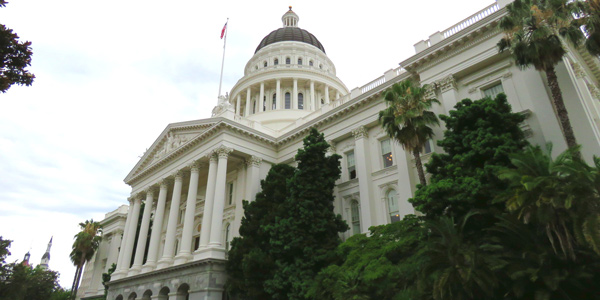By Robert Mullin
A bill that would allow CAISO’s transformation into an RTO passed another key California State Senate committee on Tuesday after supporters were grilled on how the legislation could compromise the state’s control over its energy sector.
The Senate Judiciary Committee voted 4-1 to advance AB 813 to the Appropriations Committee, typically the final step ahead of a full floor vote. Committee Chair Hannah-Beth Jackson (D) cast the sole vote in opposition.
Speaking to the committee, State Assemblyman Chris Holden (D), the bill’s sponsor, touted the potential benefits of regionalizing the ISO, a three-year effort pushed by Gov. Jerry Brown that has failed to gain traction in the legislature out of concerns about yielding control over the state’s grid and the loss of energy-related jobs.
“Expanding CAISO’s participating transmission owners will allow electricity to be treated more efficiently across the West through CAISO’s markets as more of [the West’s] 37 balancing authorities join, and without layering of multiple transmission charges,” Holden said. “This will facilitate transactions such as exporting unused renewable power, like solar, throughout the region and importing power in the evening to meet California’s steep ramp as the sun goes down.”
AB 813 passed the Assembly in June 2017 but failed to come up for a vote in the Senate and was carried over to the current session. The Senate’s Energy, Utilities and Communications Committee approved the bill June 19 on a 6-1 vote. (See Senate Committee Advances CAISO Regionalization Bill.)
Loss of Oversight?

Testifying with Holden was Ralph Cavanagh, a senior attorney with the Natural Resource Defense Council’s Climate and Clean Energy Program, who told the senators that California is already part of an integrated grid with its Western neighbors. The NRDC has been a strong proponent of regionalization.
“We’re involved in multistate grid planning now; we’re just doing it very inefficiently and at an unnecessary cost,” Cavanagh said.
He explained that while the bill would be authorizing the transition of CAISO’s state-appointed Board of Governors to a fully independent board, it would not be establishing the terms under which regionalization would proceed.
That prompted Jackson to ask: “We would lose our oversight. Is that right?”
“You have the decision to make as whether to authorize a transition to a fully independent board, and then you can pull the utilities out, senator, if for some reason you’re dissatisfied with the way the system operates,” Cavanagh said.
“But there’s a dispute as to whether we could pull them out or not,” Jackson said, referring to lingering questions about the process for removing the state’s utilities from the new RTO after they’ve joined.
Sen. Henry Stern (D) asked whether FERC would have to approve a utility’s withdrawal from the RTO.
“It’s an administrative sign-off,” Holden said.
Sen. Joel Anderson (R) expressed confusion about how the RTO’s board would be appointed and who would fill its seats.
“What the statute establishes is that a future board would be fully independent, would have no connection to any market participant,” Cavanagh said. “It would not be a board of political appointees. It would be a board of diverse experts, which is how the other boards of the independent system operators elsewhere in North America operate.”
“But where would they come from? So, they just walk in and say, ‘I’m on the board?’” Anderson asked.
Stacey Crowley, CAISO vice president of regional and federal affairs, explained that the process for selecting the board would be determined through a “public stakeholder initiative.” She noted the ISO had held workshops in 2015 and 2016 with the California Energy Commission that resulted in a proposal to create a nominating committee consisting of stakeholder representatives.
“This is not finalized, and we would go through a public process to determine that,” Crowley said.
“So the answer’s, ‘We don’t know yet,’” Jackson said.
Exporting Power, Jobs
Stern sought more information about the potential loss of California jobs if CAISO’s expansion allowed out-of-state renewables to qualify as in-state — or Bucket 1 — resources under the state’s renewable portfolio standard.
Holden acknowledged that the International Brotherhood of Electrical Workers has expressed concern about the impact of regionalization on the RPS buckets.
“We put in language to address the buckets, and in doing so, we lost a good deal of support for this bill from out-of-state wind and from others,” Holden said. “To go as far as labor would like us to go would basically end the bill.”
Representing the Coalition of California Utility Employees, Mark Joseph told the committee that the ISO’s own study shows regionalization would result in the loss of 10,500 California solar construction jobs each year from 2020 to 2030.
“What the ISO has told us is that it will assume all renewable generation outside of the current footprint will be assumed to be delivered into California and therefore qualify as Bucket 1, up to the physical constraints of the transmission system, which they have told us is 12,000 MW,” Joseph said. “So the next 12,000 MW of generation — you can kiss it goodbye.”
Sen. John Moorlach (R) asked whether load in other states was paying for California’s surplus solar energy, or whether the state’s generators were being charged to send it elsewhere.
“Senator, you’re identifying a problem with the current fragmentation, which is that sometimes we can’t use all the renewable energy that we’re producing in California and we can’t push it out to the rest of the West,” Cavanagh said. “It’s worse than paying — we have to turn off solar plants at the height of the sunshine, and one of the reasons to do [regionalization] is we’ll have access to a much bigger market. Having access to the market means more revenue for California.”
“Are you sure these states will cooperate?” Moorlach asked.
“Senator, basically they’re being offered a chance to reduce their costs,” Cavanagh said. “Almost everyone cooperates in order to do that.”









